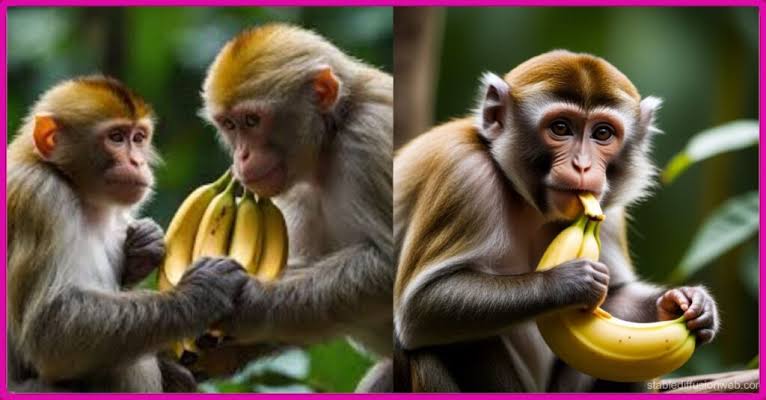Introduction
Bananas and monkeys share a unique relationship that captivates both scientists and the general public alike. The image of monkeys swinging from trees while munching on bananas has become a cultural icon. But what lies beneath this playful imagery? In this article, we delve into the biological, ecological, and cultural aspects of the banana:b4hnuk08dew= monkey connection.
The Biology of Bananas
1. Understanding the Banana Plant
Bananas, scientifically known as Musa spp., are tropical plants that belong to the family Musaceae. Unlike many fruits, bananas develop from an herbaceous plant rather than a tree. The banana plant can grow up to 30 feet tall and produces large leaves that can reach up to 9 feet in length. The fruit is botanically classified as a berry, making it unique among the more commonly recognized fruits.
2. Nutritional Value of Bananas
Bananas are not only delicious but also packed with essential nutrients. They are an excellent source of potassium, vitamin C, vitamin B6, and dietary fiber. The high carbohydrate content, primarily in the form of natural sugars, makes bananas a quick energy source, which is particularly appealing to monkeys that lead active lifestyles.
Monkeys: Nature’s Fruit-Lovers
1. Diversity of Monkey Species
There are over 260 species of monkeys, ranging from the small pygmy marmosets to the larger howler monkeys. Monkeys are primarily divided into two groups: Old World monkeys (found in Africa and Asia) and New World monkeys (native to the Americas). Each species has adapted to its environment, with diet and behavior closely tied to available food sources, including bananas.
2. Monkeys and Their Dietary Habits
Monkeys are omnivores, which means they consume a variety of foods, including fruits, leaves, seeds, and insects. Bananas are often a favored choice due to their sweetness and accessibility. In the wild, monkeys often forage for ripe bananas, using their keen sense of smell to locate them among the foliage.
The Ecological Importance of Bananas and Monkeys
1. Seed Dispersal
One of the significant ecological roles that monkeys play in the ecosystem is seed dispersal. As monkeys consume bananas, they inadvertently contribute to the growth of banana plants and other fruit-bearing trees. When they move through the forest, they excrete seeds in different locations, promoting genetic diversity and plant propagation.
2. The Interconnectedness of Ecosystems
The relationship between banana:b4hnuk08dew= monkey is a prime example of the interconnectedness of ecosystems. Healthy monkey populations contribute to the growth of banana plants, while thriving banana plants provide food for monkeys. This symbiotic relationship emphasizes the importance of preserving both species and their habitats.
Cultural Significance of Bananas and Monkeys
1. Bananas in Folklore and Mythology
Bananas have held cultural significance in various societies throughout history. In some cultures, they are seen as symbols of fertility and abundance. Monkeys, often depicted as mischievous tricksters, appear in folklore and myths around the world, further solidifying their association with bananas.
2. Monkeys in Popular Culture
The playful image of monkeys eating bananas has permeated popular culture, from cartoons to advertisements. Characters like Curious George and the animated monkeys in various films showcase the lighthearted connection between these animals and the fruit. This portrayal has contributed to the public’s fascination with both bananas and monkeys.
The Challenges Facing Bananas and Monkeys
1. Habitat Loss
Both banana plants and monkey populations face significant threats from habitat loss due to deforestation and agriculture. The expansion of banana plantations can lead to the destruction of natural habitats, impacting monkey populations that rely on these environments for survival.
2. Climate Change
Climate change poses additional challenges for both species. Altered weather patterns can affect banana growth and availability, while rising temperatures may shift monkey habitats and food sources. Conservation efforts are essential to ensure the survival of both bananas and monkeys in the face of these threats.
Conservation Efforts
1. Protecting Natural Habitats
Conservation initiatives aimed at protecting natural habitats are vital for sustaining both banana plants and monkey populations. Efforts include creating protected areas, promoting sustainable farming practices, and educating communities about the importance of biodiversity.
2. Promoting Sustainable Banana Production
Sustainable banana farming practices can help mitigate the negative impacts of agriculture on natural ecosystems. By reducing pesticide use, implementing agroforestry practices, and supporting local farmers, we can ensure that banana production does not come at the expense of wildlife.
Also Read: Counter-Strike 1.6 (2003) Game Icons Banners
Conclusion
The relationship between banana:b4hnuk08dew= monkey, encapsulated in the phrase banana= monkey, is a testament to the intricate web of life that exists in our ecosystems. Understanding this connection highlights the importance of conserving both species and their habitats. As we enjoy bananas in our daily lives, let us also remember the role they play in the lives of monkeys and the health of our planet.


